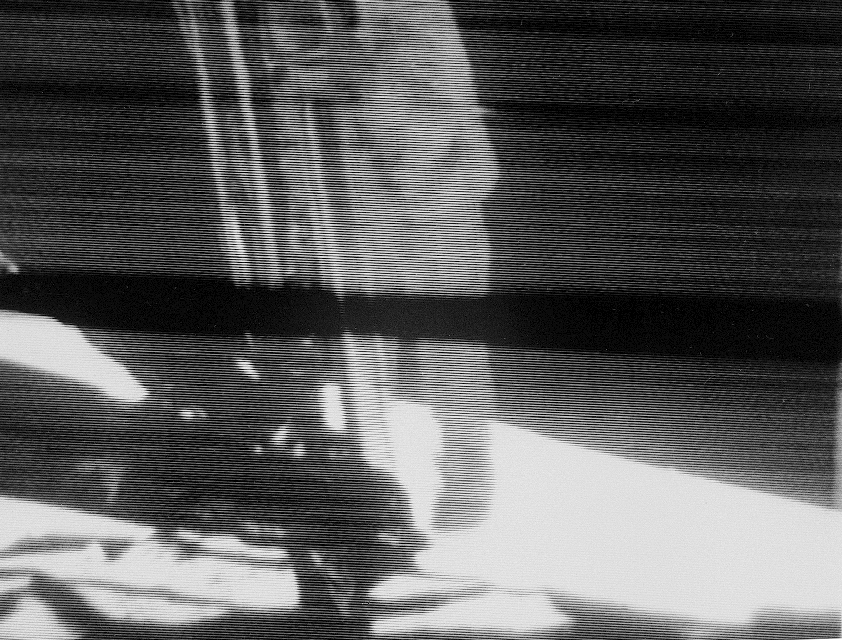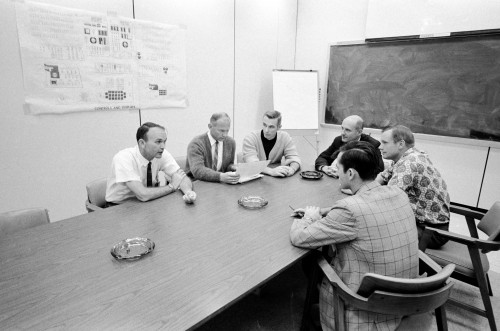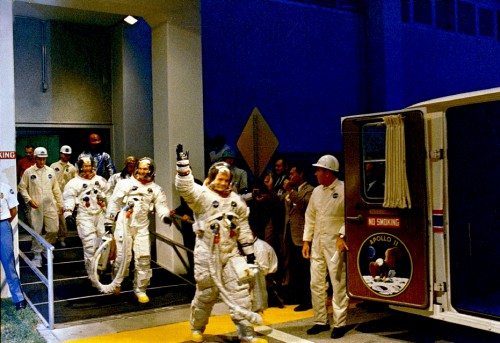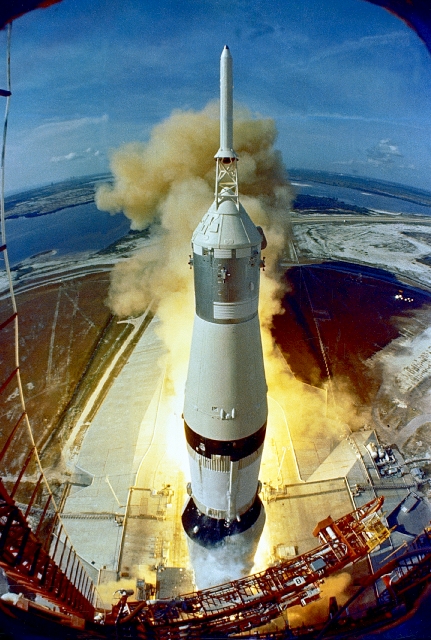
Early in July 1969, Jan Armstrong called her friend, Lurton Scott, for help. Only a few days remained before her husband, Neil, blasted off in command of the most pivotal space mission in history: Apollo 11, the voyage which would attempt the first piloted landing on the Moon. Lurton, the wife of astronaut Dave Scott, and Jan had remained good friends ever since their husbands flew together aboard Gemini VIII in March 1966. Jan had already been invited to watch the Apollo 11 launch from a motor cruiser, owned by North American Aviation and moored in the Banana River, and with Scott’s help and contacts she was able to fly from Houston to Cape Kennedy in a corporate jet. When she arrived in Florida, Jan beheld an astonishing, though unsurprising, sight: Over a million people crowded the roads and causeways of the Cape, anxiously awaiting an event whose significance which would never be seen again in their lifetimes. Forty-five years ago, this week, the first human explorers set sail to make our species’ first landfall on the Moon.
By mid-morning on 16 July, the weather was sweltering; indeed, one observer described it as being so hot that the humid air felt like a silk cloth brushing his face. Yet the historic nature of what was about to happen was magnetic. “Everybody and his brother wanted to be at the launch,” wrote Deke Slayton in his autobiography, Deke, “senators, congressmen, ambassadors.” Twenty thousand VIPs were on NASA’s official guest list, including General William Westmoreland—recently back from commanding U.S. forces in Vietnam—Johnny Carson, Vice-President Ted Agnew, and a direct descendent of Napoleon Bonaparte. Lyndon Johnson, the former president and successor to the man who had committed America to the Moon, was there, as was former NASA Administrator Jim Webb. There were also two thousand journalists in attendance, almost half of them from abroad, representing 56 nations. One Czech writer noted an overwhelming sense of goodwill, even as the ugly cloud of war continued to hover overhead: “This is the America we love,” he told his readers, “one so totally different from the America that fights in Vietnam.”
Others took the opposing view, with a handful of pro-communist newspapers operating from Hong Kong expressing criticism of the mission as an attempt to cynically distract the world from the horrors of the conflict and extend U.S. “imperialism” into the heavens.
In his role as Director of Flight Crew Operations, it was part of Slayton’s job to keep the media away from the astronauts, but even they found themselves taking late-night phone calls from long-lost relatives and old school friends in those final few days.
By launch morning, the headlights of a quarter of a million cars twinkled in the pre-dawn darkness as spectators arose from their backseats, from their tents, from beneath makeshift blankets, from inside their camper vans, and even from their boats anchored in the Indian and Banana Rivers. Those fortunate to have actually been there would later say that the proceedings did exhibit something of a “carnival” atmosphere—there were snack bars and bikini-clad spectators firing up barbecues and opening beer coolers—but the sensation was relatively calm. This was particularly true when astronauts Neil Armstrong, Mike Collins, and Edwin “Buzz” Aldrin emerged into a glare of television lights. “You get a feeling,” CBS commentator Eric Sevareid told veteran anchorman Walter Cronkite, “that people think of these men as not just superior men, but different creatures. They are like people who have gone into the other world and have returned and you sense that they bear some secrets that we will never entirely know … ”

The eyes of the world were truly riveted on this event, none more so than in Armstrong’s home town of Wapakoneta, Ohio, where his parents, Steve and Viola, watched the proceedings on a color set donated by the television network. On the evening before launch, more than two hundred cars circled the area close to their home. The mayor requested that everyone display American flags in their windows, the local dairy sold its own “Moon Cheeze,” and restaurants provided daily supplies of pies, bananas, and chips. Local children began to claim their father was Armstrong’s barber, their mother was Armstrong’s first girlfriend, and so on.
Notwithstanding this public and media frenzy, some felt that the secrets of the Moon were better left alone, until other, more pressing, more earthly issues had been addressed. In many parts of America, Apollo’s $25 billion price tag had been a hard pill to swallow, and a hefty proportion of taxpayers felt improving the education system, dealing more effectively with poverty, improving the standard of living and the civil rights of minorities, and ending the conflict in Vietnam were far greater national priorities. Reverend Ralph Abernathy, head of the Southern Christian Leadership Conference, was planning a protest with four mules and one hundred and fifty members at the Cape Kennedy gates; his particular focus was upon using Apollo money to help the poor. Still, even he was awed by the events of 16 July 1969 and the days that followed.
That Wednesday, launch was scheduled for 9:32 a.m. EDT, which dismayed Mike Collins because he had to awaken at the ungodly hour of four in the morning. His last mission, Gemini X, three years before, had blasted off in the late afternoon, allowing Collins and his commander, John Young, to get up at a more civilised time of the day, “but no such luck this time.” It was Deke Slayton who came knocking on all three men’s bedroom doors, and, after showering and dressing, they headed down to the crew quarters’ exercise room, where their nurse, Dee O’Hara, waited to perform final medical checks. Next came a final appointment with the astronauts’ cook, Lew Hartzell, and the traditional “low-residue” breakfast of steak and eggs, toast, fruit juice, and coffee—shared with Slayton and Collins’ backup, Bill Anders—followed by the laborious process of donning their snow-white space suits.
In his autobiography, Carrying the Fire, Collins related that, during the Gemini project they had suited-up in a trailer near the launch pad, but now, on Apollo, NASA had built “an elaborate suit maintenance, storage and donning facility near the crew quarters.” As each man’s helmet was snapped into place, he felt the welcome whoosh of pure oxygen rushing past his face … and the knowledge that, for the next eight days, he would breathe no more outside air; it would all come from their portable, hand-carried supplies, from the command or lunar module atmosphere or, for Armstrong and Aldrin on the surface of the Moon, from their backpacks. Lumbering outside into the blaze of television lights, all three men looked extraterrestrial, sealed as they were in their bulky suits, their protective yellow galoshes adding a slightly comical touch to their appearance.

When the transfer van arrived at Pad 39A, the astronauts ascended to the white room and were greeted by the closeout crew, including Fred Haise, the backup lunar module pilot, clad in clean-room garb and hat, who had been there for almost two hours making sure that each one of the command module Columbia’s switches was set correctly for launch. As Armstrong clambered aboard, he was handed a bon voyage gift by pad leader Guenter Wendt—a small crescent-shaped trinket, fashioned from foil-coated styrofoam—and was told that it was the key to the Moon. Unable to take it with him, Armstrong asked Wendt to keep it until he returned home, and then gave the self-styled pad “fuehrer” a mock space-taxi ticket, good between any two planets.
It was traditional, Mike Collins wrote, to present Wendt with light-hearted gifts. “Guenter has spent the past couple of weeks telling me what a great fisherman he is,” he explained in Carrying the Fire, “and how he regularly plucks giant trout from the ocean. In return, I have located the smallest trout to be found in these parts, a minnow really, and have had it, uncured, nailed to a plaque and inscribed “Guenter’s Trophy Trout”.” Secreted in a suspicious-looking brown paper bag, Collins presented the “tribute” to Wendt, then took his place in the command module’s right-hand seat.
Normally, the command module pilot occupied the center position, but Buzz Aldrin’s previous stint as backup senior pilot on Apollo 8 made it more practical to continue that way. “Collins had been out for a while” following neck surgery, wrote James R. Hansen in First Man, his acclaimed 2005 biography of Armstrong, “so rather than retrain Buzz for ascent, NASA just left him in the centre and trained Mike for the right seat.” Finally, Aldrin squeezed himself through Columbia’s hatch and dropped into the center couch.
As the minutes ticked away and the three astronauts steeled themselves for launch, one of Collins’ greatest worries was the risk of screwing up on this of all missions, under the spotlight, with a third of the world’s population watching or listening. Of key concern was the handle next to Armstrong’s left knee, which the commander could twist counterclockwise to fire the Saturn V rocket’s escape tower and pull the command module to safety in the event of an abort. Looking across the cabin, Collins noticed with horror that the pocket adorning Armstrong’s suit leg was uncomfortably close to the handle. (In fact, this was no ordinary pocket: in a few days’ time, it would be used to store a “contingency sample”—the first few grains of lunar soil ever picked up by a human being.) For now, though, Collins feared that the pocket had the potential to ruin the mission. “It looks as though if he moves his leg slightly, it’s going to snag on the abort handle,” he wrote. “I quickly point this out to Neil, and he grabs the pocket and pulls it as far over toward the inside of his thigh as he can.” It was simply too embarrassing to contemplate the headline: Moonshot Falls Into Ocean and Last Transmission From Armstrong Reportedly Was “Oops.” ...

Three minutes before launch, the automatic sequencer took command of the countdown and began a computerized run-through of each step required to pressurize the Saturn V’s internal systems before liftoff. At 50 seconds, the gigantic rocket switched to internal power and four of the nine servicing arms linking it to utilities on Pad 39A were disconnected. Seventeen seconds to go: The final alignment of the launch vehicle’s guidance computer was completed, and it was transferred to internal power.
Throughout each of these steps, the commentator continued to report what was occurring, with growing tension and excitement.
“T-15 seconds … guidance is internal … 12, 11, 10, nine … ”—then came the start of the ignition sequence, as pressurized liquid oxygen and rocket-grade kerosene (known as “RP-1”) began to enter the chambers of the five F-1 engines—“six, five, four, three … ” as internal turbines built up the supply of propellants to full flow and brought the first stage up to near-full power. As the final milliseconds of the count evaporated, all five engines were running at 90 percent of rated thrust, consuming four and a half thousand kilograms of propellant every second. Finally, as the launch pad’s deluge system flooded the flame trench with water to reduce the reflected energy, the Saturn’s internal computer carried out its last checks.
All was well.
“ … two, one, zero … all engines running … ”
At 9:32 a.m. EDT on 16 July 1969, the “Launch Commit” signal released a series of clamps holding the Saturn V to the pad and the monster began its climb for the heavens. “Liftoff … we have a liftoff, thirty-two minutes past the hour … ”
Twelve long seconds elapsed before the lumbering Saturn cleared the tower, and the hundreds of thousands of spectators began to feel the vibration and shockwaves pummeling their chests and the soles of their feet. From the commander’s seat, Armstrong could be heard announcing the onset of the “roll program” maneuver, as the Saturn V’s computer began actively guiding it out over the Atlantic Ocean and onto its proper heading for low-Earth orbit and, ultimately, in barely three days’ time, for a rendezvous with the Moon.
To the onlookers, it was nothing short of spectacular, according to Dave Scott, who was watching from the motorboat on the Banana River with Jan Armstrong. Sitting in the blockhouse at the Cape, Deke Slayton could only watch silently as the rocket thundered into a clear sky. “I think most of us felt like we were lifting it all by ourselves,” he wrote later. Tom Stafford, having ridden one of these beasts a few weeks earlier on Apollo 10, now found himself seated in Cape Kennedy’s VIP area between Lyndon Johnson and Ted Agnew, his chest blasted by the intense staccato crackle.
For the Apollo 11 crew, encased in their space suits within the very nose of the behemoth, the sensations were unlike their previous experiences. All three men had previously ridden the Titan II rocket, but, rather than the sudden G forces at the instant of liftoff, “there was an unexpected wobbly sway,” wrote Buzz Aldrin in his memoir, Men from Earth. “The blue sky outside the hatch window seemed to move slightly as the huge booster began its pre-programmed turn after clearing the tower. The rumbling grew louder, but it was still distant.” For his part, Collins felt that the Saturn was “a gentleman” compared to the Titan; despite the shock of staging, the G loads seemed to build no higher than 4.5 and the whole ride proceeded as “smooth as glass, as quiet and serene as any rocket ride can be.”
The Saturn behaved with perfection, executing each step of its flight regime precisely: The S-IC first stage burned out and separated two minutes and 40 seconds into the climb, followed at three minutes and 17 seconds by the jettisoning of the escape tower—which allowed sunlight to flood the cabin. For almost six more minutes, they rode the S-II second stage’s five exceptionally smooth J-2 engines, and then the single J-2 of the “crisp and rattly” S-IVB third stage. When this stage shut down eleven minutes and 40 seconds after launch, it was travelling at in excess of 17,600 mph (28,800 km/h) in a circular parking orbit at an altitude of 116 miles (187 km). By this point, Apollo 11 was barely four percent of its weight at liftoff.
Despite having launched into orbit atop the largest and most powerful rocket ever brought to operational status in human history, the men of Apollo 11 had yet to even begin their primary mission. Even the three-day journey to the Moon was a trail already blazed by two previous Apollo crews. Not until 20 July 1969 would Armstrong, Collins and Aldrin truly enter the realm of the unknown.
The second part of this article will appear tomorrow.
Want to keep up-to-date with all things space? Be sure to “Like” AmericaSpace on Facebook and follow us on Twitter: @AmericaSpace




Ben – marvelous recounting of the lead-up to launch and launch. I look forward to the rest of your piece. Those were magical times for those of us on the sidelines.
Rod P.
Re-reading that brought back so many memories of watching it on TV in 1969. It seems like only yesterday for me.
Hi Rob and Gary,
Many thanks for your kind words. I wasn’t born until 1976, so I envy you both for having experienced this momentous event for real.
Ben
With a 45-year perspective on this, the most significant and daring of all human endeavors, it is incredible that we accomplished such a feat. If one reads the many books on Apollo, one realizes the complexities of the missions. Hansen’s, “First Man,” is the definitive biography and answers many questions about Armstrong and Apollo 11. Other books such as, “How Apollo Flew to the Moon,” give the reader the “mathematics” of how we accomplished the moon missions.
Ben’s essay provides superlative details that those of us who were lucky enough to live at the time of the first lunar landing appreciate. It’s the kind of detail that is sometimes lost to a generation not around at that time.
Ben – outstanding work and looking forward to tomorrow’s article!